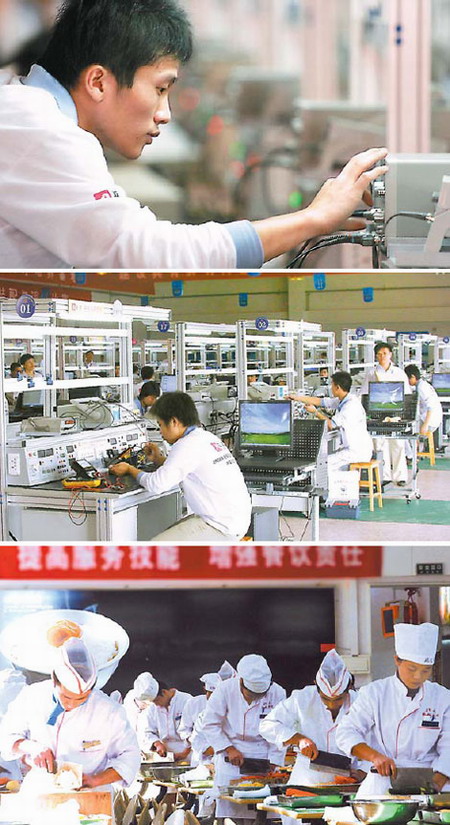
|
BIZCHINA> 30 Years of Reforms
 |
|
Related
Nation promotes vocational education
By Liu Jie (China Daily)
Updated: 2008-09-03 10:45
 Management talents and engineers may be in short supply, but what the Chinese business sector needs most is skilled workers and technicians. As China's manufacturing industry has climbed up the value chain since the beginning of economic reforms 30 years ago, the demand for highly skilled blue-collar workers on the factory floor has been growing.
Despite that, factory owners traditionally pay blue-collar workers, even the highly skilled ones, disproportionately low salaries compared with those at the management level. Not enough workers are therefore willing to spend the time and the effort to acquire skills in their trade, leading to a shortage of technicians since the late 1990s. To solve this problem, the government began to promote vocational education, which can help ease the pressure on universities and increase job opportunities for urban youth. According to China Statistics Yearbook, there were 11,570 secondary vocational schools around the nation with over 3 million students in 2003. The number of schools rose to 11,813 and that of students crossed 14 million in 2006. At the same time, the number of schools for skilled workers stood at 2,884, while that of students jumped from 2.35 million in 2003 to 3.21 million in 2006. People's Daily reported in 2006 that the central government planned to invest 10 billion yuan in vocational training in the 2006-10 period, with an annual enrollment target of 8 million. Minister of Education Zhou Ji said at a recent national meeting that China will enroll 8.2 million students in secondary vocational schools this year. He also said that to attract more students to secondary vocational schools, the government will offer more financial support, build a better school management system and try to improve teacher training. But more than a government push, the development of vocational education in China needs corporate support, which may involve cooperation with schools to increase the practical skills of students, offering internship opportunities as well as providing on-the-job training for existing workers. And more important than that is an improvement in salary levels and social status, which will automatically attract more urban youth to the factory floor.

(For more biz stories, please visit Industries)
|
主站蜘蛛池模板: 成人免费观看www在线 | 欧美毛片性视频区 | 欧美日韩一区二区三区在线观看 | 欧美一级欧美三级在线 | 精品久久久久久国产免费了 | 免费看一级欧美毛片视频 | 国模偷拍在线观看免费视频 | 久久91精品牛牛 | 午夜欧美日韩在线视频播放 | 一级毛片在线看 | 国产a级三级三级三级中国 国产a级特黄的片子视频 | 亚洲精品区 | 99久久99热精品免费观看国产 | 亚洲综合国产 | 亚洲国产精品成 | 欧美老妇免费做爰视频 | 国产成人在线播放视频 | 美国特级毛片 | 目韩一区二区三区系列片丶 | 欧美日韩国产在线观看一区二区三区 | 国产欧美日韩图片一区二区 | 亚洲精品一区二区三区中文字幕 | 美国的毛片免费的 | 精品视频在线观看 | 一个人看的www日本高清视频 | 久久全国免费久久青青小草 | 久久综合成人网 | 特级毛片永久久免费观看 | 国产欧美一区二区三区免费 | 国产手机在线小视频免费观看 | 亚洲欧美日韩高清在线看 | 国产黄毛片 | 亚洲日本中文字幕在线 | 国产精品欧美一区二区 | 久操免费在线 | 在线播放国产真实女同事 | 日本高清色本在线www | 91精品国产免费久久国语蜜臀 | 国产手机精品一区二区 | 三级精品| 国产精品久久久久久搜索 |